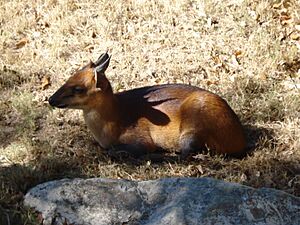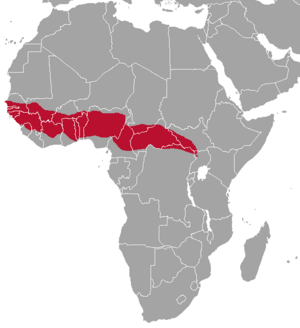Red-flanked duiker facts for kids
Quick facts for kids Red-flanked duiker |
|
|---|---|
 |
|
| Red-flanked duiker, Cephalophus rufilatus | |
| Conservation status | |
| Scientific classification | |
| Genus: |
Cephalophus
|
| Species: |
rufilatus
|
 |
|
| Distribution of red-flanked duiker | |
The red-flanked duiker (Cephalophus rufilatus) is a small type of antelope. You can find it in western and central Africa, from Senegal all the way to Sudan. These duikers are about 15 in (38 cm) tall and can weigh up to 31 lb (14 kg).
They have reddish-brown fur on their bodies, with grayish-black legs and backs. Their bellies are white. Red-flanked duikers eat leaves, fallen fruits, seeds, and flowers. Sometimes, they also munch on twigs and shoots. Adult duikers like to stay in their own areas, called territories. They live in grassy plains (savannah) and lightly wooded places. Female duikers usually have one baby each year. In zoos, they can live for ten to fifteen years.
Contents
What Does a Red-Flanked Duiker Look Like?
The red-flanked duiker is one of the smallest antelopes. It stands about 34 to 37 centimetres (13 to 15 in) tall and weighs around 12 to 14 kilograms (26 to 31 lb). Its head and body are dark gray near its spine. This color slowly changes to a reddish-brown on its neck and sides.
It has small white marks on its ears and nose. A dark stripe runs down the middle of its face. A tuft of black hair grows between its horns. More coarse, dark hairs grow along the top of its neck. Its legs are bluish-gray.
Horns and Glands
Male and female duikers look quite similar. However, males have short horns that point backward. These horns can be up to 9 centimetres (3.5 in) long. Females often do not have horns, or their horns might be shorter.
Both males and females have large glands in front of their eyes. These glands make their cheeks look a bit lumpy. All duikers in the Cephalophus group have these glands. But in the red-flanked duiker, they are bigger than in other species.
Where Do Red-Flanked Duikers Live?
The red-flanked duiker lives in West and Central Africa. Its home stretches from Senegal and Gambia in the west. It goes all the way to Sudan and the Nile Valley in the east.
These duikers mostly live in open savannah woodlands. They also like the edges of forests. You can also find them in river areas with tall elephant grass (Pennisetum purpureum). They also live in thick bushes like caperbushes (Capparis spp.) and tree acanthus (Acanthus arboreus).
How Red-Flanked Duikers Behave
Red-flanked duikers are very protective of their space. They are mostly solitary animals, meaning they live alone. Sometimes, a pair will live in a small area for a few months. Then they move to a new spot. They mark their territory using a special liquid from their face glands.
They are most active in the early morning and just before it gets dark. While they eat, they are always watching for danger. If they get scared, they lower their heads and quickly hide in the closest thick bushes.
Who Hunts Red-Flanked Duikers?
Several animals hunt red-flanked duikers. These include leopards (Panthera pardus), crowned eagles (Stephanoaetus coronatus), and African rock pythons (Python sebae). Sadly, people also hunt them. In fact, humans probably hunt more duikers than all other predators combined.
What Do Red-Flanked Duikers Eat?
Red-flanked duikers eat leaves, flowers, and fruits that fall from trees. They also nibble on twigs that grow close to the ground. They enjoy eating from many different plants. Some of their favorite foods include the wild date palm (Phoenix reclinata) and the African peach (Nauclea latifolia). They also like the Cape fig (Ficus capensis) and the wild bauhinia (Piliostigma thonningii).
When a duiker eats fruits like the Cape fig, African peach, or wild date, it swallows the seeds. These seeds pass through their body and come out in their droppings. This helps spread the seeds for these plants, helping new plants grow.
Red-Flanked Duiker Life Cycle and Reproduction
Both male and female red-flanked duikers become adults at about nine months old. The female can have babies once a year. She carries her baby for about eight months. A single baby is usually born during the dry season or when the wet season begins.
A newborn duiker weighs about 1 kilogram (2.2 lb). It quickly hides in nearby plants. It only comes out when its mother returns to feed it. Right after birth and when cleaning her baby, the mother marks it with her face gland liquid. The baby stops drinking milk when it weighs about 9 kilograms (20 lb). After that, the parents do not care for it anymore.
Conservation Status of the Red-Flanked Duiker
The red-flanked duiker can adapt to different environments. When trees are cut down and their forest homes become more open, they can actually expand where they live. They are fairly common in the areas where they are found. However, their numbers are generally going down. This is because of a lot of hunting pressure.
The red-flanked duiker is often hunted for bushmeat. It was one of the most common types of bushmeat sold in the Republic of Guinea. Even so, they live in several protected areas and reserves. In these places, they are less likely to be hunted for meat. Because of this, the International Union for Conservation of Nature (IUCN) lists the red-flanked duiker as a species of "Least Concern" on its Red List of Threatened Species. This means they are not currently in great danger of disappearing.


